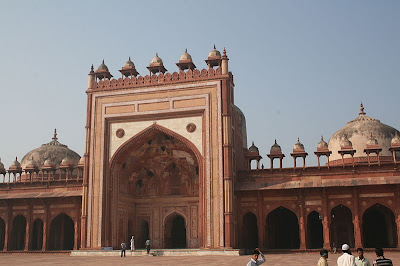Although Akbar was a successful warrior and ruler, he is best remembered as a patron of intellectual and artistic life. He encouraged architecture, painting, and poetry. He embraced the tolerant Sufi attitude toward non-Muslim ideas, and one of his first acts as ruler was to abolish the tax paid by non Muslims. His court included many Hindu grandees.
Akbar liked to stage debates between scholars of the different religions, and especially like to have Jain holy men at court. This led to a cycle of legends concerning Akbar's Nine Wise Men. These stories are set at Fatehpur Sikri, where many of the actual religious debates took place. Above is a near-contemporary painting of Akbar entertaining Jesuits and other scholars at Fatehpur Sikri.
The architecture of Fatehpur Sikri is in the style developed by the Mughals, drawing on disparate parts of their empire: central Asia, Iran, and India.
This is the Jama Masjid or Friday Mosque.
The tomb of Salim Chisti.
The palace came with the ultimate luxury, a board for playing pachisi with humans for the pieces.
This was inspired, like all my Indian Palace posts, by The Royal Palaces of India, by George Michell and Antonio Martinelli (Thames and Hudson 1994).












No comments:
Post a Comment